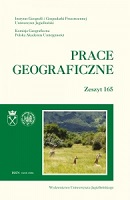Kryteria identyfikacji miast na świecie
Criteria for identifying cities/towns in the world
Author(s): Dorota Dymek, Jolanta JóźwikSubject(s): Applied Geography, Methodology and research technology, Demography and human biology
Published by: Wydawnictwo Uniwersytetu Jagiellońskiego
Keywords: city/town; definition; urban criteria; world; UN; censuses;
Summary/Abstract: Despite the fact that urban areas have existed for millennia, no single, universal, supranational, and fully accepted definition of a city/town has been developed to date. The aim of this article is to review the criteria for identifying cities/towns in the world and their spatial differentiation. 233 territorial entities that are sovereign states or territories belonging to other states were surveyed. The analysis was based on a query from a list provided by the Department of Economic and Social Affairs of the United Nations Population Division, which contains the definitions of cities/towns adopted by individual countries or territories when collecting data in censuses. The research carried out shows that singleor multicriteria definitions, referring to quantitative or (and) qualitative elements from the group of legal-administrative, demographic, infrastructural-spatial, and functional criteria, are most often used to distinguish cities/towns from villages. More than half of the surveyed territorial entities use only one criterion mentioned, and this is usually a legal-administrative criterion or a demographic criterion. In the process of identifying cities/towns, just over two-fifths of the surveyed entities apply a minimum population threshold (as the only or one of many criteria), set most often at 2,000 or 5,000 inhabitants. East Africa is the most diverse region in the world in terms of the criteria adopted, while Central Asia, Australia, and New Zealand are the least.
Journal: Prace Geograficzne
- Issue Year: 2021
- Issue No: 166
- Page Range: 9-26
- Page Count: 20
- Language: Polish

